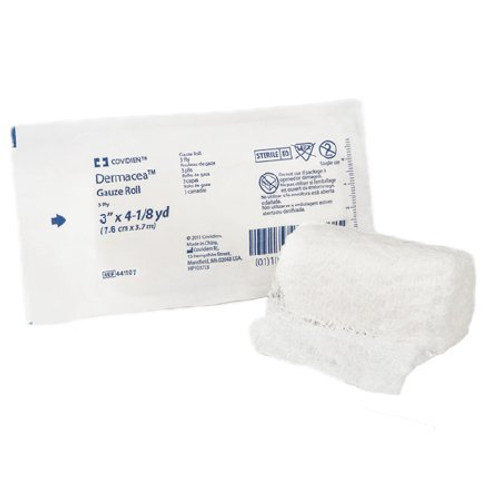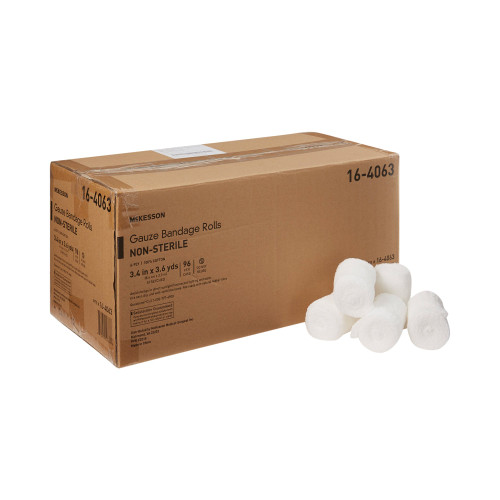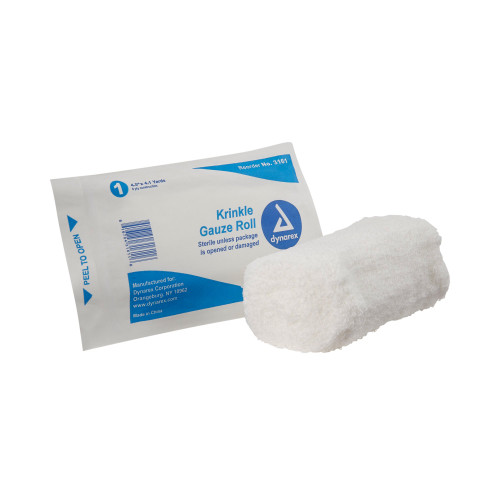-

Covidien
Dermacea Cotton / Polyester 1-Ply Conforming Bandage 96 per Case
Package Count: 96. Dermacea low ply gauze rolls are made of prewashed, fluff-dried 100% woven gauze for soft, absorbent performance and comfort. Conforming bandage is often used for securing dressings, IVs, splints or for providing mild compression and...
$64.99 -
 $14.99
$14.99 -

McKesson
McKesson Conforming Bandage - Cotton Woven Gauze for Wound Care
Roll of conforming nonsterile cotton/polyester bandage
As low as $17.29 -

Covidien
Dermacea Gauze Bandage Roll - Sterile Fluff Woven Gauze
Dermacea gauze rolls are made of prewashed, fluff-dried 100% woven gauze for soft, absorbent performance and comfort.Made of prewashed, fluff-dried 100% woven gauze with a crinkle-weave pattern for loft and bulk to cushion and protect wound areas As a...
As low as $93.74 -

Hartmann
Hartmann Peha-haft Absorbent Cohesive Bandage, Self-Adherent Gauze
This cohesive, conforming bandage is safe dressing retention for use on joints and conical or rounded parts of the body. Also can be used for fixation of cannulae, padding material, etc.High absorption capacity Skin-friendly alternative to tape for those...
$19.85 -

Covidien
Dermacea Fluff Bandage Roll - Cotton Woven Gauze for Wound Care
Dermacea low ply gauze rolls are made of prewashed, fluff-dried 100% woven gauze for soft, absorbent performance and comfort. Often used for securing dressings, IVs, splints or for providing mild compression and support.Made of prewashed, fluff-dried...
$76.00 -

McKesson
McKesson Gauze Bandage Rolls- 6-Ply, Cotton, Non-Sterile, 3.4 x 3.6 in
Package Count: 96. McKesson gauze bandage rolls are made of 100% prewashed, fluff-dried woven cotton to provide maximum absorbency. Its low-linting formulation helps minimize the risk of fibers being left behind in the wound bed. It may be used as a...
$106.03 -

Covidien
Kerlix Gauze Bandage Roll, Absorbent Fluff Wound Dressing
Kerlix bandage rolls provide fast-wicking action, superior aeration, and excellent absorbency. They are made of prewashed, fluff-dried 100% woven gauze with crinkle-weave pattern for loft and bulk to cushion and protect wound areas. Finished edges on the...
As low as $10.25 -

McKesson
McKesson Trauma Dressing - Sterile, Non-Woven Wound Care Pad
McKesson trauma dressing is intended for use in first aid applications, e.g. lacerations, fractures, abrasions/burns, penetration wounds.Sterile For first aid applications: Lacerations, fractures, abrasions/burns, penetration wounds Absorbent Single use
As low as $10.41 -

Dynarex
Dynarex Gauze Roll, 6-Ply Crinkle Fluff-Dried Woven Gauze
Crinkle gauze roll has good absorption properties and helps to retain ointment, creams and wound discharge. It's made of washed woven gauze that's fluff dried for improved softness. The six-ply construction provides added protection, allowing for use as...
As low as $6.80 -

Dukal
Dukal Fluff Bandage Roll - Absorbent Gauze for Wounds
Secure dressings and maintain patient comfort during recovery with a Dukal Fluff Bandage Roll. It's made of 100 percent cotton, washed and fluff-dried to achieve a lightweight and soft feel. The Dukal Fluff Bandage Roll also features an open crinkle...
$114.56
Conforming & Rolled Gauze

Conforming and Rolled Gauze
Conforming bandages, often called rolled gauze, stretch, and mold to otherwise difficult areas to cover. Rolled gauze can also work as a secondary bandage to hold another one in place.
Conforming Vs. Rolled Gauze
A gauze bandage roll most of the time refers to non-sterile conforming bandages. A conforming bandage is typically sterile, but can still be called rolled gauze, as the material and purpose of the two types of the bandage are nearly identical. For example, non-sterile rolled gauze and a conforming bandage often go together to cover wounds on areas like elbows, knees, and other places where flexing and movement could dislodge more conventual wound care.
Types of Conforming Bandages
Conforming bandages vary in thickness from 1-ply to 6-ply bandages. They can be either fluffy or flat. They are generally more expensive than non-sterile gauze rolls but will resist bacteria and clean open wounds. For closed wounds that still need to be protected, non-sterile conforming bandages may do the trick.
Conforming bandages and rolled gauze are usually used for wounds on limbs, specifically those near or on joints. If you are not sure which is the right choice, talk to your healthcare provider or opt for the sterile product if that is not possible. Just keep in mind that once the packaging of a sterile bandage has been opened, it may no longer be considered sterile unless it can be resealed.
You can also use a non-sterile gauze roll to cover a sterile bandage like a trauma bandage and hold it in place. This enables you to keep the wound sterile but can provide a less expensive wrap.
Understanding Plys
The higher the ply, the more absorbent and protective the bandage. A one-ply bandage is light and can absorb minor amounts of discharge from a wound. A six-ply bandage is much more absorbent for a wound with a higher amount of discharge.
Sizes of Gauze Rolls and Conforming Bandages
Gauze rolls and conforming bandages come in a number of sizes, including but not limited to:
1 Inch X 4-1/10 Yard
1 Inch X 1-7/10 Yard
2 Inch X 4-1/10 Yard
2 Inch X 5 Yard
2-1/4 Inch X 3 Yard
3 Inch X 4-1/10 Yard
3 Inch X 4-1/2 Yard
3 Inch X 5 Yard
3-2/5 Inch X 3-3/5 Yard
4 Inch X 4-1/10 Yard
4-1/2 Inch X 4-1/10 Yard
Choose the size of conforming bandage you will use based on the size and shape of the wound. You’ll want sufficient coverage but not too much overlap.
What Conforming Bandage or Rolled Gauze is Right for You?
First, decide if you need a sterile or non-sterile gauze bandage and if you will be using some of each as a primary and secondary dressing. Then, determine the amount of fluid the injury will produce. After, you can choose the right size to cover the shape of the wound. This will determine the type of bandage you will need to purchase.
When caring for any wound, be sure to consult your physician or wound care professional if you have any questions or before starting any treatment regimen.
Conforming bandages, often called rolled gauze, stretch, and mold to otherwise difficult areas to cover. Rolled gauze can also work as a secondary bandage to hold another one in place.
Conforming Vs. Rolled Gauze
A gauze bandage roll most of the time refers to non-sterile conforming bandages. A conforming bandage is typically sterile, but can still be called rolled gauze, as the material and purpose of the two types of the bandage are nearly identical. For example, non-sterile rolled gauze and a conforming bandage often go together to cover wounds on areas like elbows, knees, and other places where flexing and movement could dislodge more conventual wound care.
Types of Conforming Bandages
Conforming bandages vary in thickness from 1-ply to 6-ply bandages. They can be either fluffy or flat. They are generally more expensive than non-sterile gauze rolls but will resist bacteria and clean open wounds. For closed wounds that still need to be protected, non-sterile conforming bandages may do the trick.
Conforming bandages and rolled gauze are usually used for wounds on limbs, specifically those near or on joints. If you are not sure which is the right choice, talk to your healthcare provider or opt for the sterile product if that is not possible. Just keep in mind that once the packaging of a sterile bandage has been opened, it may no longer be considered sterile unless it can be resealed.
You can also use a non-sterile gauze roll to cover a sterile bandage like a trauma bandage and hold it in place. This enables you to keep the wound sterile but can provide a less expensive wrap.
Understanding Plys
The higher the ply, the more absorbent and protective the bandage. A one-ply bandage is light and can absorb minor amounts of discharge from a wound. A six-ply bandage is much more absorbent for a wound with a higher amount of discharge.
Sizes of Gauze Rolls and Conforming Bandages
Gauze rolls and conforming bandages come in a number of sizes, including but not limited to:
Choose the size of conforming bandage you will use based on the size and shape of the wound. You’ll want sufficient coverage but not too much overlap.
What Conforming Bandage or Rolled Gauze is Right for You?
First, decide if you need a sterile or non-sterile gauze bandage and if you will be using some of each as a primary and secondary dressing. Then, determine the amount of fluid the injury will produce. After, you can choose the right size to cover the shape of the wound. This will determine the type of bandage you will need to purchase.
When caring for any wound, be sure to consult your physician or wound care professional if you have any questions or before starting any treatment regimen.
